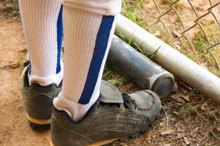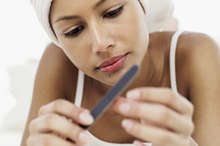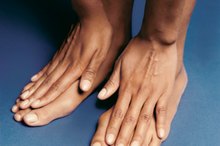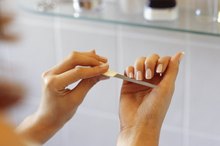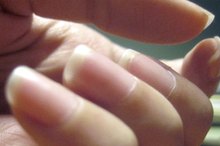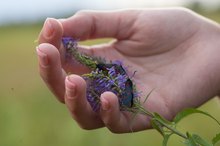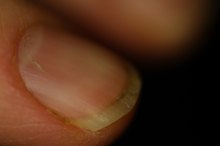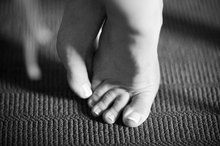What Is Keratin Debris?
Hair and nails are made predominantly from proteins. Depending on the type of protein used, the structures made can be soft and pliable, like hair, or be designed for sturdiness, as is the case with nails. Some conditions, such as a fungal infection, can break down these proteins. One such protein, known as keratin, can be destroyed and turned into keratin debris.
Keratin Identification
Kertain is a protein that encompasses the part of the nail known as the nail plate. This protein is made of many layers of dead and flattened skin cells, Hooked-On-Nails.com says 1. Skin cells contain large amounts of keratin. When they die, the keratin inside the cells can be converted into the nails that cover the fingers and toes.
- Kertain is a protein that encompasses the part of the nail known as the nail plate.
- When they die, the keratin inside the cells can be converted into the nails that cover the fingers and toes.
Keratin Debris
Small Red Bumps on the Bottom of the Foot
Learn More
Keratin debris is formed due to infections of keratin-rich areas. Keratin debris can be caused by a fungal infection known as onychomycosis. Fungi that infect the nails can destroy small amounts of keratin, resulting in the formation of keratin debris, the Merck Manual explains. Keratin debris is formed as a result of the nails being physically broken down by the fungi.
- Keratin debris is formed due to infections of keratin-rich areas.
- Keratin debris is formed as a result of the nails being physically broken down by the fungi.
Symptoms
When keratin debris builds up under the nails, it causes small bits of discoloration to appear under the nail, typically around the edges. This debris may be yellow or white. The nail can also become thickened and yellow, and may begin to separate from the nail bed.
Prevention
What to Do for a Ripped-Loose Fingernail?
Learn More
The best way to prevent keratin debris from accumulating under the nails is to prevent fungal nail infections. To do this, it's important to keep the fingers and toes clean; they should be washed every day. In addition, people trying to prevent fungal nail infections should remove dirt from under their nails and keep the nails closely trimmed and clipped.
Treatment
If keratin debris builds up as a result of a fungal nail infection, topical creams that combat the fungi can be applied to the affected areas. Keratin debris can also be removed using a manicure tool, PRWeb.com notes, but creams may need to be applied to soften the nails and the debris to make it easier to scrape the debris out from under the nail.
Related Articles
References
- Hooked-On-Nails: Nail Anatomy
- PRWeb: Foot Care
- Bragulla HH, Homberger DG. Structure and functions of keratin proteins in simple, stratified, keratinized and cornified epithelia. J Anat. 2009;214(4):516-59. doi:10.1111/j.1469-7580.2009.01066.x
- Jacob JT, Coulombe PA, Kwan R, Omary MB. Types I and II keratin intermediate filaments. Cold Spring Harb Perspect Biol. 2018;10(4):a018275. doi:10.1101/cshperspect.a018275
- Moll R, Divo M, Langbein L. The human keratins: biology and pathology. Histochem Cell Biol. 2008;129(6):705-33. doi:10.1007/s00418-008-0435-6
- Greenwold MJ, Bao W, Jarvis ED, Hu H, Li C, Gilbert MT, Zhang G, Sawyer RH. Dynamic evolution of the alpha (α) and beta (β) keratins has accompanied integument diversification and the adaptation of birds into novel lifestyles. BMC Evol Biol. 2014;14:249. doi:10.1186/s12862-014-0249-1
- Hassan MM, Carr CM. A review of the sustainable methods in imparting shrink resistance to wool fabrics. J Adv Res. 2019;18:39-60. doi:10.1016/j.jare.2019.01.014
- Thomas M, Khopkar US. Keratosis pilaris revisited: Is it more than just a follicular keratosis?. Int J Trichology. 2012;4(4):255-8. doi:10.4103/0974-7753.111215
- American Academy of Dermatology. Actinic keratosis: Overview.
- MedlinePlus. Epidermolytic hyperkeratosis.
- Madke B, Gutte R, Doshi B, Khopkar U. Hyperkeratotic palmoplantar lichen planus in a child. Indian J Dermatol. 2013;58(5):405. doi:10.4103/0019-5154
- Basit A, Asghar F, Sadaf S, Akhtar MW. Health improvement of human hair and their reshaping using recombinant keratin K31. Biotechnol Rep (Amst). 2018;20:e00288. doi:10.1016/j.btre.2018.e00288
- Patel DP, Swink SM, Castelo-Soccio L. A review of the use of biotin for hair loss. Skin Appendage Disord. 2017;3(3):166-169. doi:10.1159/000462981
- Crum EM, McLeay YD, Barnes MJ, Stannard SR. The effect of chronic soluble keratin supplementation in physically active individuals on body composition, blood parameters and cycling performance. J Int Soc Sports Nutr. 2018;15(1):47. doi:10.1186/s12970-018-0251-x
- Pierce JS, Abelmann A, Spicer LJ, Adams RE, Glynn ME, Neier K, Finley BL, Gaffney SH. Characterization of formaldehyde exposure resulting from the use of four professional hair straightening products. J Occup Environ Hyg. 2011;8(11):686-99. doi:10.1080/15459624.2011.626259
- Swenberg JA, Moeller BC, Lu K, Rager JE, Fry RC, Starr TB. Formaldehyde carcinogenicity research: 30 years and counting for mode of action, epidemiology, and cancer risk assessment. Toxicol Pathol. 2013;41(2):181-9. doi:10.1177/0192623312466459
Writer Bio
Adam Cloe has been published in various scientific journals, including the "Journal of Biochemistry." He is currently a pathology resident at the University of Chicago. Cloe holds a Bachelor of Arts in biochemistry from Boston University, a M.D. from the University of Chicago and a Ph.D. in pathology from the University of Chicago.
